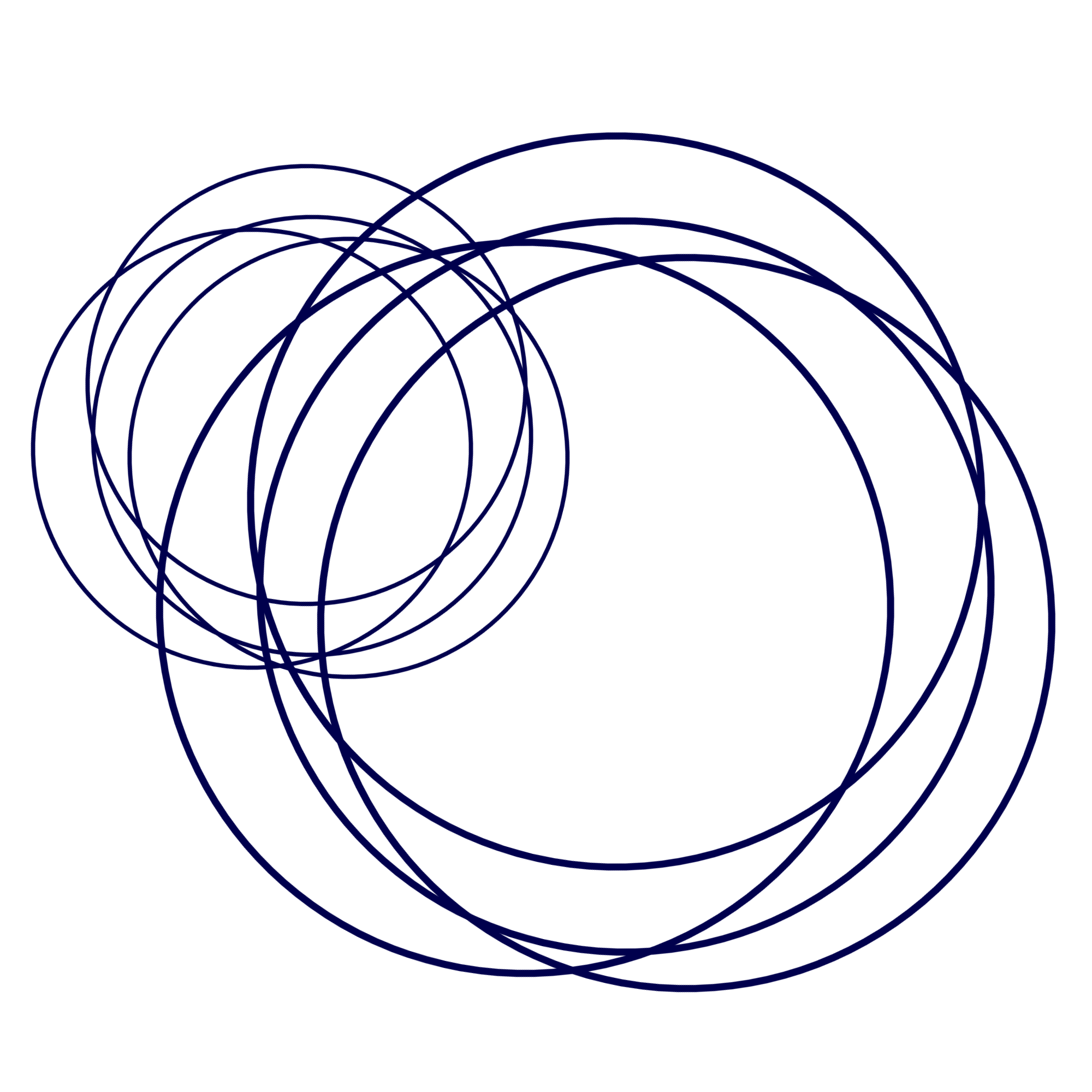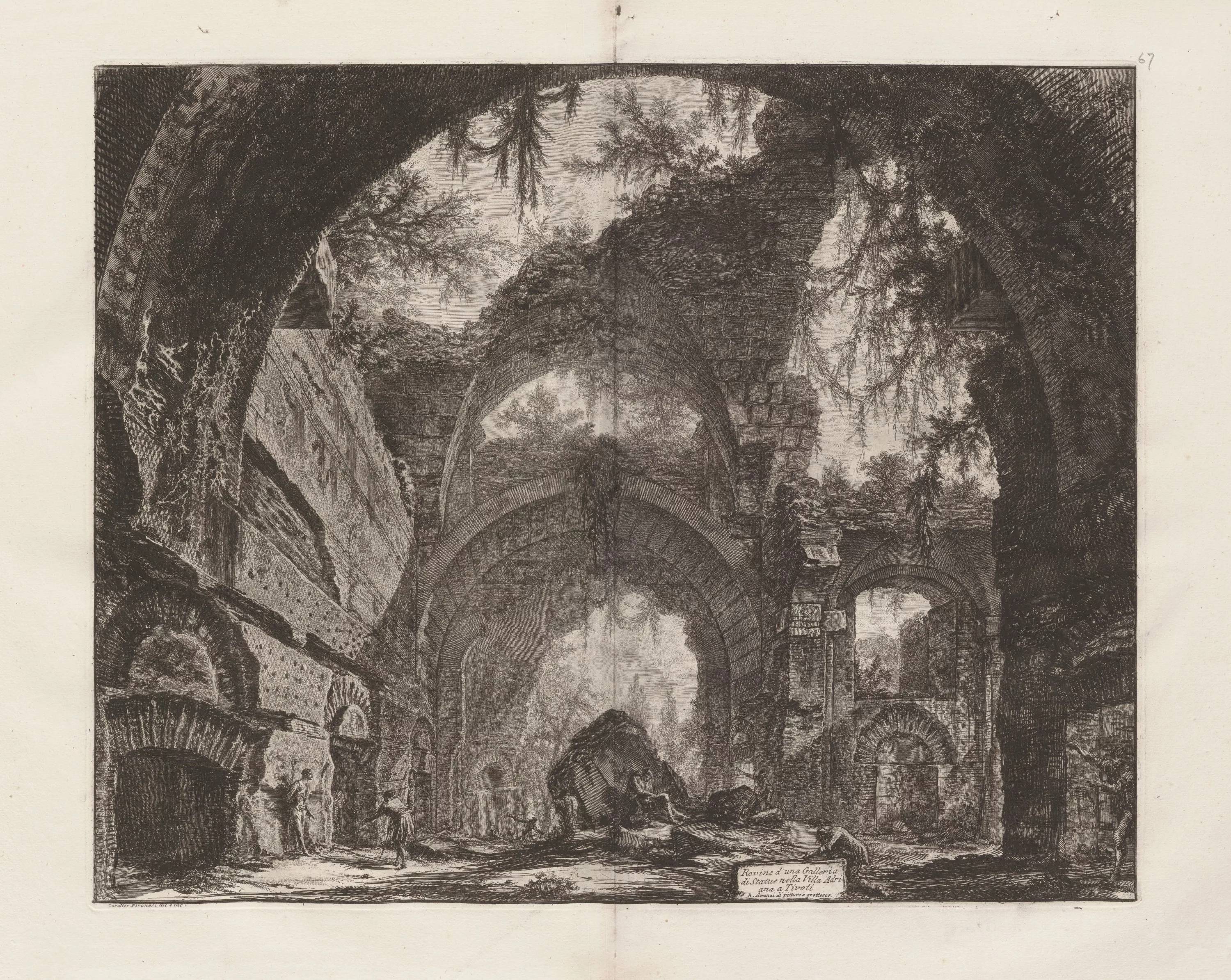Exhibit
Creation Date
1770
Height
45.5
Width
58
Medium
Genre
Description
This engraving depicts a ruined architectural interior that opens to the sky even as it is emphatically enclosed by successive archways that are overgrown with draping vines. Inaccurately identified in the caption as the ruins of a statue gallery near Hadrian’s Villa, this structure is in Piranesi’s rendition a meditation on architectural surface and depth as well as their visual representations.
Piranesi’s Vedute di Roma [Views of Rome] series, begun in 1748, expanded the popular genre of the veduta [view], which traditionally offered realistic depictions of architecture or landscape, and, in keys or captions, often identified particular buildings and monuments. The medium of print and the genre of the annotated view provide Piranesi with productive tools for historical inquiry, aesthetic creation, and knowledge production. Along with his imaginary prisons, Piranesi is known for his depictions of ancient Roman ruins that are etched with sumptuous attention to their crumbling surfaces, teeming with botanical life, cast in dramatic chiaroscuro, and populated by haggard, stooped men. Piranesi described his motivation for depicting Roman ruins by declaring, in the dedication to his Antichità Romane, that he wanted to “conservarli col mezzo delle stampe” [conserve them by means of print] (Piranesi, Opere, vol. 1 p. 1). In the dedication of his Prima Parte di Architetture e Prospettive [First Part of Architecture and Perspective] (1743), he said that the architectural remains of ancient Rome, more than the drawings of Renaissance architect Andrea Palladio (1508-1580), “spoke” to him: “io vi dirò solamente, che di tali immagini mi hanno riempiuto lo spirito queste parlanti ruine, che di simili non arrivai a potermene mai formare sopra i disegni, benchè accuratissimi, che di queste stesse ha fatto l’immortale Palladio, e che io pur sempre mi teneva innanzi agli occhi.” [I would only say that these speaking ruins have filled my spirit with images of a kind which even precise drawings such as those by the immortal Palladio, which I always kept before my eyes, can never conjure up.] (Nyberg and Mitchell 115). In his annotated views of ruins, ancient architecture seems to speak, in a different way, to his viewers and readers. His annotations break the illusion of visual art, and they combine immersive, imposing images with information and conjecture.
The evocative power of ruins has drawn notable insights from cultural studies, art history, and literary theory, and with etchings such as this, Piranesi contributed to the ruins craze of the second half of the eighteenth century despite betraying no such attraction in his writings. While studies of ruins in British and French contexts have emphasized the melancholic strain in responses to the inevitable decline and decay that ruins seemed to signify, the Italian context, in light of Giambattista Vico’s circular notion of historical change, resists linear models of history. Piranesi’s vedute are both evocative images and documents of the production of knowledge whose interactions between words and images demonstrate a predisciplinary intertwining of aesthetics and archaeology.
Piranesi engraved 14 views of structures and landscapes in Tivoli, where Hadrian’s Villa was built as a retreat outside of Rome during the early second century CE. When viewed as a group, as they are presented in the Opere, Piranesi’s views of the ruins at Tivoli are graphical representations of the pursuit of archaeological and historical knowledge. By the second half of the eighteenth century, the ruins occupied land that was difficult to access and divided among various property owners. Indeed, Piranesi’s visits to Tivoli, often in the company of architects and artists including Robert Adam, Charles-Louis Clerisseau, or Claude-Joseph Vernet, required extensive clearing of vines and weeds. The assortment of buildings that emerged made Tivoli both a more active archaeological site than other locations in central Rome and a venue for the production of historical knowledge: as structures were identified, mosaics uncovered, and inscriptions deciphered, material evidence summoned processes of conjecture and interpretation. These processes appear throughout the visual and verbal elements of Piranesi’s depictions of Tivoli in annotations that specify the uncertain names, effaced ornamentation, or unknown details of the villa’s structures. As visual compositions as well as word-image composites, Piranesi’s views of this site in particular are equally significant for their architectural content and their visual forms.
In this image, the near symmetry of the archways is interrupted by the small key, which presents a title and minimal information. Ruins themselves serve as deictic pointers, as signals of what was but no longer is. Along these lines, in this image, the caption’s “A” indicates remains of decorative frescoes visible in the upper-right corner. Similar frescoes from Hadrian’s villa are reproduced in Piranesi’s Antichità Romane (which “View of the Tomb Chamber of L. Arruntius” comes from) and Vasi, Candelabri, Sarcofagi, Tripodi Lucerne et Ornamenti Antichi (which his “Ancient Marble Urn” comes from).
Although Giovanni’s identification of the structure as a statue gallery is now considered incorrect, this supposed function informs the significance of his composition. (His son and collaborator Francesco later accurately referred to it as the passageway to the complex’s baths.) To populate what is, at the time of composition, assumed to be a sculpture gallery with human figures engaged in varied postures, stances, and gestures is to invite a comparison between present living bodies and lost immobile statuary, between past and present.
Publisher
Firmin Didot
Collection
Additional Information
This digital image is from a complete 29-volume set of Piranesi’s posthumous Opere (1835-1839) held by the Irvin Department of Rare Books and Special Collections, University Libraries, at the University of South Carolina. It was scanned in the Digital Collections Department. The set was likely acquired directly from the publisher, and the cover of each volume bears the imprint of the name of the university up through 1866: South Carolina College.

